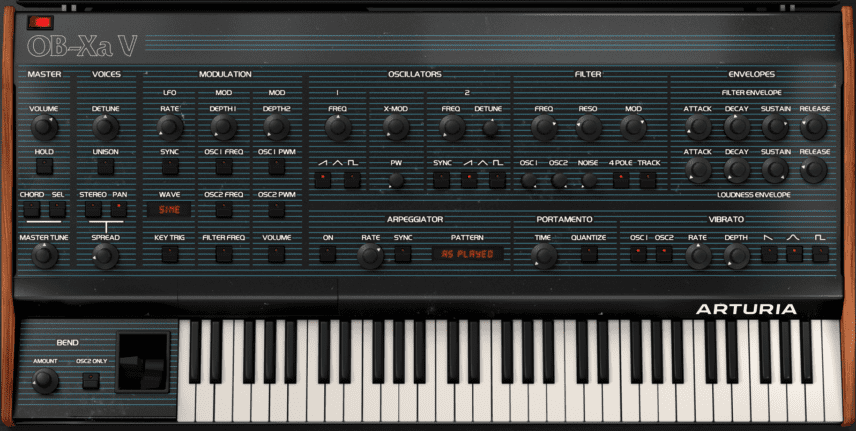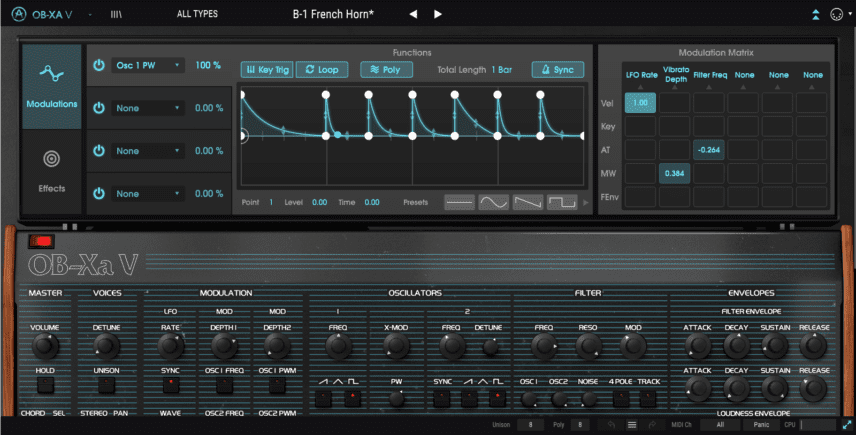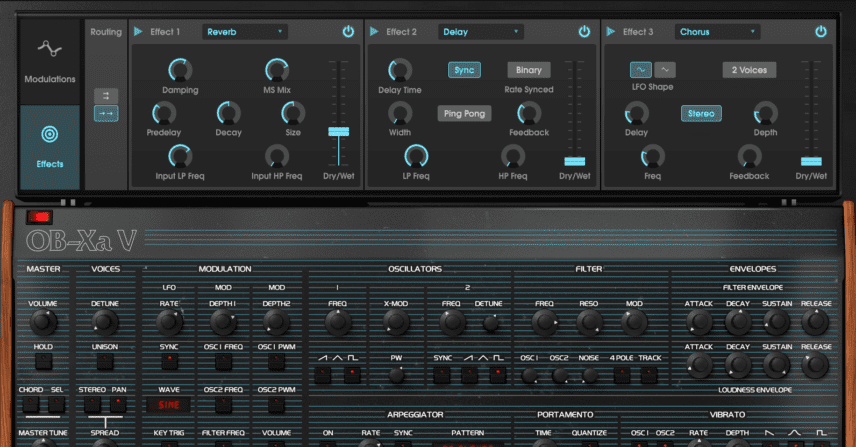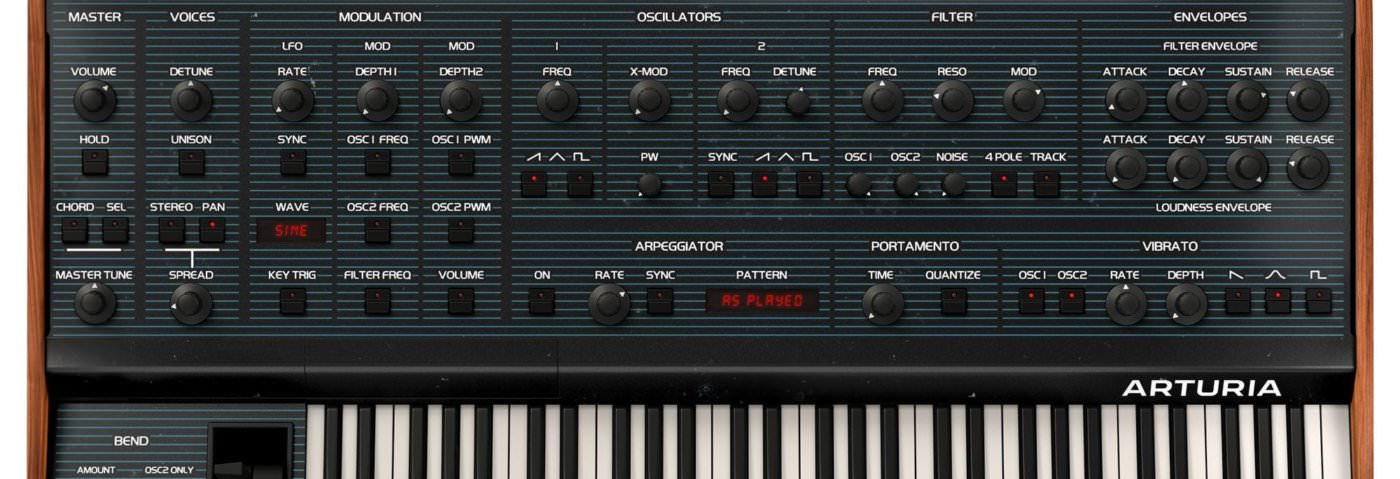Arturia finally adds the Oberheim OB-Xa to its list of emulations. But is it good enough to stand out in a very crowded polysynth plugin field?
In 1980, American synthesizer manufacturer Oberheim unleashed the OB-Xa, a very lush (and very expensive) polyphonic synthesizer that would come to define the sound of the 1980s. If the sound of synth-pop was built largely with affordable Japanese synthesizers, then the dominating sound of the ‘80s (particularly American top 40 radio) was the OB-Xa. It was all over Prince’s 1999 album, Queen’s ‘80s output, and most famously “Jump,” in which Van Halen proved that big synth leads could hold their own with guitars in the world of rock.
Key to the OB-Xa’s success was its (to use a current Americanism) yugeness. Oberheim calibrated each analogue synth voice independently, giving it a massive, growly sound that is immediately recognizable. Anyone who’s heard Underground Resistance’s “OB-Xa” (released under the name X-102) can testify to this. It was most often used for big chord sounds—think brass, strings, and pads, although it was no slouch in the bass department either. It also looked the business. With its horizontal blue pinstripes and generous real estate, it set synth fans’ hearts aflutter (including this ‘80s kid) whenever one appeared in a music video.
Enter the Arturia OB-Xa V. The OB-Xa was one of Arturia’s most-requested emulations. As usual, the company was not content to just crank out another spot-on emulation but also updated the synth’s functionality in key ways, taking inspiration from the OB-Xa’s predecessor and successor, the OB-X and OB-8, along the way. But the real question is, does the world need yet another 1980s polysynth emulation?
Improving The Original
The original OB-Xa was a deceptively simple polyphonic synthesizer, with fairly limited synthesis options when compared to modern units. Oberheim would go on to release the Xpander and Matrix-12, machines that introduced the idea of the modulation matrix to modern synths, but at this point things were relatively straightforward. Two oscillators, each with saw and square waveforms. A simple filter. Three LFOs, two envelopes, and a few extras like unison and chord memory. And that’s it really. What it lacked in synthesis options, it made up for in sound, one that dropped jaws and convinced musicians to part with $6000 (or roughly $18,000 in today’s money).

Oberheim made the original available in four-, six-, and eight-voice configurations but Arturia have upped this to 16 voices (making the unison mode even fatter than before) in the OB-Xa V. Arturia have beefed up the oscillator section as well, adding a triangle wave to the original sawtooth and square waves. As with the original, there’s also pulse width on both oscillators as well as pulse width modulation controllable via LFO. It’s thick and woolly and very satisfying.
Another close look at the oscillators reveals sync as well as cross modulation, something available on the OB-X but not on the OB-Xa. It’s a welcome addition and significantly expands the synthesis possibilities. We also like the way tuning has been handled. Oscillator one’s tuning knob has been restricted to feet, and oscillator 2’s to semitones, making dialling in oscillator settings a breeze compared to completely free tuning. There’s also a detune on oscillator 2 for extra thick spread.
Smooth Filter
The OB-Xa filter is less-known (or emulated) than the SEM and Matrix-12 filters. Based on the Curtis CEM3320 filter (the same as Sequential Circuits’ Prophet 5 Rev 3), it’s a two-pole (12dB/octave) lowpass filter with a button to switch to four-pole mode. It’s rather gentle, especially in four-pole mode, and doesn’t self-oscillate but this was never the intention. You switch on an Obie when you need big, smooth, and classy. That being said, the filter will bite if you need it too. There is a noticeable drop in volume when engaging the 4 Pole button, however, something to keep in mind when programming.
The filter section also houses the oscillator mixer, which Arturia have helpfully improved, bringing it from on/off buttons to standard rotaries. Cheers for that.
Low Frequency Improvements
The LFO section has three LFOs, which can be routed to the frequency of oscillators 1 and 2, filter frequency, pulse width for either oscillator, and the volume for tremolo-style effects. LFO rate can handily be synced to tempo. While the original LFO only had sine, square, and sample and hold, Arturia have added triangle, ramp, square, and a smoothed sample and hold, useful for subtle, random movement in pads. Lastly, they’ve added a key trigger button to reset the LFO with each key press. There’s also a new, dedicated vibrato section, handy for quick Boards Of Canada-style pitch wobbles.

One of the more interesting features of the OB-Xa’s successor, the OB-8, was its stereo panning functionality. Each individual voice could be panned independently to create a huge soundstage. Arturia have added this to the OB-Xa V, along with stereo controls for the LFO, oscillators, and even filter. There’s also stereo width control over the unison mode.
Other improvements include a pop-up graphic for setting chord memory (for rave-style chord stabs) and an arpeggiator with a number of modes, including “as played,” useful for riffing and improvising.
Effects And Function Generators
As with other Arturia emulations, the OB-Xa V includes a comprehensive effects section that appears at the top of the screen when either a button or the upper edge of the front panel is clicked. This includes your usual reverb, delay and chorus—perfect for adding that final ‘80s touch—as well as some less-expected offerings like a bipolar flanger, phaser, overdrive, compressor, and multimode filter. There are three slots for effects, and they can be run in series or parallel configurations.

There’s also a series of function generators, essentially loopable envelopes, which can control virtually all the parameters. You can choose from any number of preset envelope shapes or of course draw your own. There’s also a modulation matrix (another Oberheim touch) for assigning input modulators like velocity or the mod wheel to destinations.
The Verdict
There’s a lot to like in Arturia’s OB-Xa V. We love that it’s a kind of greatest hits package of the later Obies. The control over stereo is particularly useful, as are the effects and modulation possibilities. And of course, there’s the sound. For brass, pads, and big sounds in general, it can’t be beat.
It has to be said though that the competition for ‘80s poly emulations is pretty stiff. At $199, it’s on the higher end of the price spectrum, out-pricing U-he’s Prophet 5-inspired Repro (€149) and even Arturia’s own CS-80 V ($149). Of course, these are not Oberheim emulations. When it comes to the OB-Xa, there isn’t much to compare to. DiscoDSP has their OB-Xd ($49), but it’s based on the OB-X, and IK Multimedia has an Oberheim pack, OXa ($49), for Syntronik, but these are of course samples and not an emulation.
So does the world need another ‘80s poly emulation? If it’s the OB-Xa V, the answer is yes. It recreates one of the most iconic synths of all time and adds plenty of useful and modern functionality to it. It’s perfect for any ‘80s-inspired genre like synthwave, nu disco, or even soundtrack work. If you’ve been waiting for an OB-Xa emulation, then I think your decision has already been made. If you’re not already an Obie-head and are on the fence, you could always wait until Arturia makes it a part of the V Collection—assuming they do.
